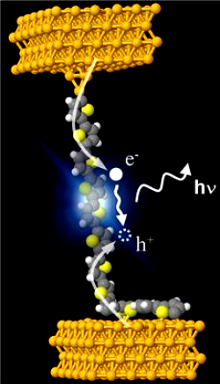Single molecule LED leaps to miniature extreme
 Engineers have created an LED consisting of a single molecule, reaching the end point on the race to make miniature light sources.
Engineers have created an LED consisting of a single molecule, reaching the end point on the race to make miniature light sources.
The single molecule LED is formed by propping a long thin molecule in between a sheet of gold and a minuscule metal pin.
While the development may one day lead to mind-boggling resolution on display screens, augmented reality contact lenses or anything in between, for now it will stay in the lab to inform further research into light emission at a scale where quantum physics takes precedence over classical physics.
In technical terms, the team placed single polythiophene wire between the tip of a scanning tunnelling microscope and a gold surface. In this configuration, the thiophene wire acts as a light emitting diode; light is emitted when a current passes electrons from the tip of the microscope towards the gold surface. When the polarity was reversed, light emission was negligible.
For every 100,000 electrons injected into the thiophene wire, a photon was emitted, putting its wavelength in the red range.
The work is also a first step towards making molecule-sized components that combine electronic and optical properties. Similar components could form the basis of a molecular computer.
More details are available in the full report, accessible here.








 Print
Print